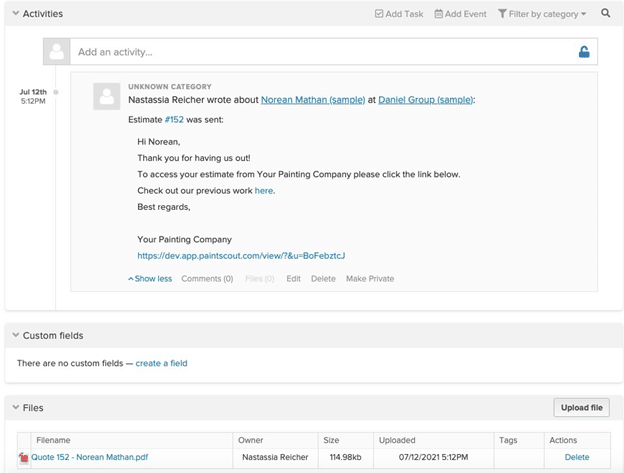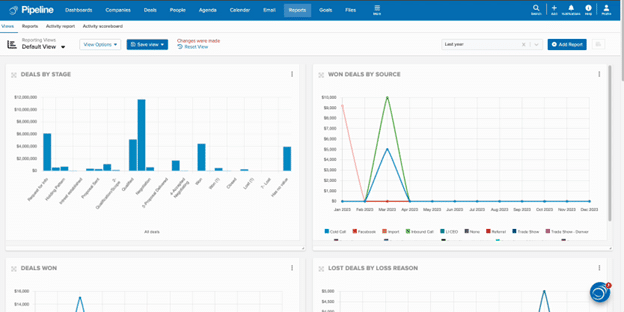Contractors often lose potential customers simply due to a busy schedule. It’s an easy mistake to make—but one that can hurt your business.
Here’s a common scenario:
A prospective customer calls for a quote. You take their information and promise to follow up. But as work piles up, weeks pass before you realize the call was never returned. By then, the customer has moved on, possibly leaving a negative impression that could impact future business.

Many contractors lose potential jobs simply because they lack a system to manage their bids, follow-ups, and client communication. Bids fall through the cracks without proper tracking, leading to missed revenue opportunities.
That’s where a construction CRM comes in. By centralizing bid tracking, automating follow-ups, and providing clear visibility into your sales pipeline, a CRM helps contractors stay organized and improve their win rates. In this article, we’ll explore why a CRM is essential for managing construction bids and how it can streamline your entire sales process.
Why Contractors Ignore Potential Customers
Ignoring customers is rarely done with bad intentions. Most of the time, the reasons have nothing to do with the customer. When contractors overlook a customer, it usually comes down to one of the following issues:
- You’re too busy with current projects: you have all the customers you can handle right now and can’t take on another project.
- You’re overwhelmed with customer inquiries: you’re becoming well-known for being a dependable contractor and suddenly receive a spike in customer demand.
- A potential project is too small: saying no to a high-effort, low-reward project could lead to a negative review, so it’s easier not to respond.
- You don’t want to work with problem customers: you’re not getting back to this customer as their reputation precedes them.
- Organization is a challenge: you’re a small team, and it’s difficult to keep up with the avalanche of information from customers.
If you’re an experienced contractor, none of this is new. You can probably think of at least one instance where these reasons applied to you.
The bad news is that it’s not good enough anymore. If your construction company is going to survive, you’ll have to track construction bids and consistently follow up using a construction CRM. This ensures no lead falls through the cracks by helping you track, organize, and follow up effectively.
Why Following Up With Customers is No Longer Optional
At any given time, only 3% of your prospects are ready to buy. This is what’s happening with the rest:
- 7% plan to make a change soon.
- 30% have a need but aren’t ready yet.
- 30% don’t have a need right now.
- 30% will never buy from you.
This means most leads require consistent follow-up to convert. Without a structured approach, you risk wasting time on bad-fit prospects or losing qualified leads due to poor tracking.
A strong bid management process ensures:
- Pre-qualified prospects only: sending bids to the wrong prospects drains time and resources.
- Clearly defined deal stages: knowing where bids succeed or fail helps you improve your sales process.
- A two-way qualification process: prospects should meet set criteria before moving forward.
- Follow-up expectations are set upfront: scheduling follow-ups before submitting a bid keeps the process on track.
Ignoring follow-ups means losing potential revenue, but a CRM ensures no bid falls through the cracks and helps you manage the process efficiently.
How to Use a CRM to Keep Track of Construction Bids
Let’s explore how a CRM can help you set up, manage, and track construction bids efficiently, using Pipeline CRM as an example.
Step 1: Customize Deal Stages

Remember the deal stages we mentioned earlier?
We’re going to use those here to set up our examples. Before using them in your business, you’ll want to customize these deal stages. Let’s use the following deal stages:
- Contact
- Lead qualification
- Site visit/needs assessment
- Proposal/quote
- Negotiation
- Contract signing
- Project start
Deal stages allow you to track a project from beginning to end. With deal stages, you’ll be able to:
- Qualify/disqualify prospects
- Shepherd customers through your pipeline
- Identify problem areas or gaps in your sales process
- Identify areas where sales reps need more training
- Assign data-driven values to each stage
Your customers should earn their way to the next stage. For example, if a contact reaches out to you and requests a quote, you’ll need to qualify the customer or project. You’d want to ask the following questions:
- What’s your budget?
- Is their project in your service area?
- What’s their time frame?
- How will they pay for the project?
- Who will be the project point of contact?
If these prospects give you the needed information, they can move to the needs assessment stage. If you’ve done an assessment and their project is a fit, and they’re willing to agree to your proposal/bid terms, they’ve earned a bid or proposal.
Don’t move customers forward in the process if they haven’t earned it.
Step 2: Record All Bids and Opportunities
Many companies make the mistake of putting all the responsibility in their sales rep.
They expect their sales reps to enter all the bids and opportunities from start to finish. This approach works if your sales reps aren’t overloaded or already juggling a lot.
This is where integrations save the day. If you semi-automate the process and automatically enter contact data, you’ll find getting employees to record all opportunities is much easier.
Here’s a list of the integrations you’ll need.
- Webform integration: if you integrate your CRM and web forms, you can automatically transfer data from your website forms and landing pages to your CRM directly.
- BCC tracking: if your CRM has BCC tracking, your CRM should add prospects to contact lists whenever you send a copy of the email to your CRM. Your sales reps spend zero time on manual data entry, which enables you to set up deals immediately.
- Email integrations: your CRM should integrate with your email tools, especially if you use popular tools like Outlook or Google Workspace. These CRM integrations should help you find, track, and add new contacts. You can also send trackable email messages showing whether your messages were opened or unread.
- Accounting integrations: your CRM should offer two-way integration with popular accounting software and tools. What does this mean? You should be able to sync contacts across both apps (e.g., Pipeline and Quickbooks) and create and view invoices in both apps; you should also be able to send invoices from your CRM (Pipeline in this case) without needing to open Quickbooks.
- Proposal and contract integrations: your CRM should integrate with the tools you’re using to create proposals and contracts. Sales reps should be able to pull these docs into your CRM automatically without switching from one app to another. For example, you should be able to attach a PDF of your proposal or estimate for the appropriate deal to your account. Any activity or change made in one app should be reflected in the other.

Source: PaintScout.com
All the stages in your pipeline that require data entry can be automated or semi-automated. You can pull in all the needed data, consistently recording bids and opportunities. This means sales reps and project managers spend their time working on the portions of deals that actually require their attention.
So, looking at the deal stages in our example:
- Contact
- Lead qualification
- Site visit/needs assessment
- Proposal/quote
- Negotiation
- Contract signing
- Project start
Automated sales processes can (and should) address the areas in bold.
When you set these integrations up, you automatically import all contact data into your business. This is important because it tells you (a.) that the contact or data exists, so an opportunity should exist for it as well, and (b.) dramatically reduces data entry errors.
Step 3: Create Follow-Up Cadence
When it comes to follow-up, there are two behaviors you should avoid becoming:
- Beggar: this type of salesperson evokes feelings of pity, directly or indirectly. Customers often find begging off-putting, thinking, “Your offer can’t be very good if you have to beg for business.” If they make a purchase, it’s often accompanied by resentment, such as, “I only bought because I felt sorry for you.”
- Pest: while many sales representatives neglect follow-up, some go to the other extreme. They never stop contacting you, bombarding you with incessant, unhelpful messages like, “Got time for a quick call?” or “I’m just checking in to see where things are at.” These salespeople are relentless and never let potential deals fizzle out.
Both of these behaviors become more harmful over time. The problem is that sales reps are easily tempted to engage in these behaviors without a predetermined follow-up system.
How should you follow up on bids?
A 1:3 cadence ensures consistent follow-ups without overwhelming prospects. This approach helps qualify leads throughout the follow-up process while keeping communication structured.
How the 1:3 cadence works:
- For every one message or offer sent, follow up at least three
- Space each message appropriately, giving prospects time to respond.
- If a prospect stops responding, send a direct check-in to confirm their interest.
- If they remain unresponsive, move them to a lead nurturing
- If they explicitly decline, remove them from active outreach.
Here’s the 1:3 cadence in action.
Message #01: Request for Proposal
Subject: We’ll send you a proposal in 48 hrs. or less.
Hi [Customer],
Appreciate you taking the time to iron out the details of your project. As soon as it’s ready, I’ll send you a link to the proposal. It’ll have all of the details and important next steps. Before I do, when are you free to go over the proposal?
Best,
[Signature]
Message #02: Proposal Follow-Up 1
Subject: Who gets to see your proposal?
Hey [Customer],
Who should get a link to your proposal? Is it just you, or are there others who should receive access to this?
Let me know,
[Signature]
Message #03: Proposal Follow-Up 2
Subject: Never heard back. What do you want to do?
Hey [Customer],
Haven’t heard from you about a time to go over the proposal. Are you still interested in moving forward with this project?
Let me know,
Message #04: Proposal Follow-Up 3
Subject: Have you given up on this project?
Hey [Customer],
Have you given up on this project? If your situation has changed, please let me know so we can update things on our end.
Let me know,
[Signature]
If customers continue to ghost you at this stage, place them on a lead nurturing campaign.
The 1:3 cadence works whether you’re sending out email campaigns, making phone calls, or sending out text messages to your customers. It’s an important point of balance that helps to maintain the quid pro quo nature of selling.
Not sure what to say about each of these deal stages? You can customize these templates for your construction business.
Deal Stage: Contact
Hi [Customer],
You mentioned that you’re looking for a team to help you with your [project]. We can help you with that. Can you tell me more about what you’re looking for?
[signature]
Deal Stage: Lead Qualification
Hi [Customer],
Thanks for the details on your [project]. We’ve worked with several other [customers] in the past on a similar project in your area. Before we continue further, we typically [expectation] before we can get started on your project.
Is that okay?
[signature]
Deal Stage: Site Visit or Needs Assessment
Hi [Customer],
We’ll need to come to your location to finish our assessment. Here’s a link to our calendar—please choose a date and time that works well for you.
Talk soon!
[signature]
Deal Stage: Proposal or Quote
Hi [Customer],
I appreciate you taking the time to iron out the details of your project. As soon as it’s ready, I’ll send you a link to the proposal. It’ll have all of the details and important next steps. Before I do, when are you free to go over the proposal?
Best,
[Signature]
Deal Stage: Negotiation
Hi [Customer],
Do the terms laid out in our proposal or agreement work for you? Please let me know if I can clear up any questions or concerns before we move forward.
Best,
[Signature]
Deal Stage: Contract Signing
Hi [Customer],
Thanks for trusting us to take care of your upcoming project! It’s been a genuine pleasure working with you so far, and I look forward to doing great things together. Take a look at the agreement and sign it when you’re ready.
We’ll be all set from there!
Best,
[Signature]
Deal Stage: Project Start
Hi [Customer],
Welcome aboard! We’re excited to show you what we can do. Our crews will be set to start work on [date/time]. Please make sure that you have someone on hand to provide our crews with the access they need.
Let’s get to work! 🙂
[Signature]
You can add three follow-up messages to each of the deal stages messages above. If you want your sales reps to be seen as equals during the sales process, you’ll need to maintain a healthy balance between giving and receiving.
With a CRM, these emails can be automated so no lead is forgotten, automatically triggering follow-ups at the right intervals. This approach keeps prospects engaged and increases the chances of closing the deal.
Step 4: Monitor Bid Status and Progress
If you’re using a CRM, you should receive a mix of alerts on the status and progress of each project.
- Real-time alerts or notifications: these notifications tell you when activity related to a lead or deal in your pipeline occurs. This includes when tasks are assigned, a call is logged, an email is opened, or a deal stage changes.

- Activity alerts: your CRM should guide your sales team and set meaningful objectives for each of your sales reps. You should be able to track the work your sales reps do every day. Your CRM should provide you with a high-level overview of the historical account of your pipeline, won or lost deals, your active pipeline, deal stage status, and more.

- Deal status updates: you should be able to track the health of each project or deal at a moment’s notice. You should be able to see if the deal is healthy, has slowed, or stopped. This shows you the deals that need immediate attention.

These alerts, trackers, and notifications give you the precious intel you need to track your construction bids. If progress has slowed, stalled, or stopped, you’ll know immediately. These are essential must-haves if you’re shopping for a CRM.
Step 5: Collaborate With Your Sales Team
Using this data, you can have conversations.
If you picked the right CRM and have done the upfront work, you have lots of data to use to make decisions. It’s a straightforward process—the details in these alerts give you the action steps you need to make important changes in your sales process.
If you’ve done this properly, you should know:
- What it takes to pre-qualify your customers
- Which customers are qualified
- Which deals/projects you’re willing to take on (or not)
- How to communicate your decision to customers
- What your sales reps are doing (daily, weekly, monthly)
- How to send fewer proposals but close more deals
- What each project is worth to your construction company
- The steps you need to follow consistently to close deals
These questions come from tracking and monitoring performance and outcomes. If you know the role of a CRM and you’re using it to monitor the performance and outcomes of several groups, you should be looking at:
- Prospects
- Customers
- Sales reps
- Project managers
- Vendors
Each person has a role to play. By tracking performance and outcomes, you can quickly identify the source of any problems in your pipelines.
Step 6: Analyze Performance Reports and Make Changes

There are lots of things you can analyze.
What’s important is focusing your attention on the right reports. When it comes to closing deals, sales managers need to focus their attention on these specific areas:
- Number of SQLs (sales-qualified leads): are we getting enough qualified leads? How many of these prospects lead to revenue?
- Customer engagement: are customers willing to engage with us and provide us with the information and support we need to help them with their projects?
- Deals by stage: which projects have bids out? How many of these projects are moving to negotiation or closing? Which deals have stalled? Why?
- Win/loss ratios: how many of our projects do we win? More than half? Less than half?
- Reasons for win/loss: why did we win, and how can we win more? Why did we lose, and how do we fix the problems or reasons for our loss?
- Bid value: are the projects we win profitable to our construction company? Can we afford to take on more of these projects over time?
- Sales forecasts: are we bringing in more profitable customers/projects or less? Are we on track to meet or exceed our sales quotas?

If we’re focused on these areas, we can drill down to identify the causes of each of our outcomes. What if you’re looking for different categories or types of data?
Your CRM should show you the following:
- Who’s doing what and when (activity tracking)
- How much potential revenue is in your pipeline (deal stages)
- How much revenue you’re on track to close (sales forecasting)
- Which deals are on track
- Which deals need immediate attention (deal insights)
These are simple reports that you can customize. Sure, there is CRM reporting you can analyze, but these are essential if you’re relying on your CRM to help you track, follow up with, and close your construction bids.
Contractors Using Pipeline CRM Never Overlook Their Customers
A prospective customer calls, texts, or emails to request a quote. Your CRM automatically imports their information and assigns tasks to the right sales reps. Customers are immediately greeted and acknowledged. Your sales team has coordinated around your CRM—two weeks later, you’re working on negotiating terms and moving to close the deal.
Now, this deal is yours forever.
Tracking bids and following up consistently is the key to winning more construction projects. The right CRM ensures every lead is captured, every follow-up is timely, and no opportunity is lost due to disorganization. With Pipeline CRM, you can automate follow-ups, manage bids efficiently, and keep your sales pipeline moving.
Don’t let potential deals slip away—try Pipeline CRM today.



